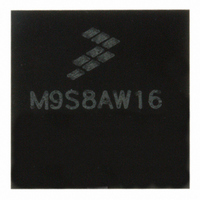MC9S08AW16MFGE Freescale Semiconductor, MC9S08AW16MFGE Datasheet - Page 35

MC9S08AW16MFGE
Manufacturer Part Number
MC9S08AW16MFGE
Description
IC MCU 8BIT 16K FLASH 44-LQFP
Manufacturer
Freescale Semiconductor
Series
HCS08r
Datasheet
1.MC9S08AW32CFDE.pdf
(324 pages)
Specifications of MC9S08AW16MFGE
Core Processor
HCS08
Core Size
8-Bit
Speed
40MHz
Connectivity
I²C, SCI, SPI
Peripherals
LVD, POR, PWM, WDT
Number Of I /o
34
Program Memory Size
16KB (16K x 8)
Program Memory Type
FLASH
Ram Size
1K x 8
Voltage - Supply (vcc/vdd)
2.7 V ~ 5.5 V
Data Converters
A/D 8x10b
Oscillator Type
Internal
Operating Temperature
-40°C ~ 125°C
Package / Case
44-LQFP
Lead Free Status / RoHS Status
Lead free / RoHS Compliant
Eeprom Size
-
Available stocks
Company
Part Number
Manufacturer
Quantity
Price
Company:
Part Number:
MC9S08AW16MFGE
Manufacturer:
Freescale Semiconductor
Quantity:
10 000
Part Number:
MC9S08AW16MFGE
Manufacturer:
FREESCALE
Quantity:
20 000
- Current page: 35 of 324
- Download datasheet (4Mb)
the CPU executes a STOP instruction, the MCU will not enter either of the stop modes and an illegal
opcode reset is forced. The stop modes are selected by setting the appropriate bits in SPMSC2.
HCS08 devices that are designed for low voltage operation (1.8V to 3.6V) also include stop1 mode. The
MC9S08AW60 Series family of devices does not include stop1 mode.
Table 3-1
3.6.1
The stop2 mode provides very low standby power consumption and maintains the contents of RAM and
the current state of all of the I/O pins. To enter stop2, the user must execute a STOP instruction with stop2
selected (PPDC = 1) and stop mode enabled (STOPE = 1). In addition, the LVD must not be enabled to
operate in stop (LVDSE = 0 or LVDE = 0). If the LVD is enabled in stop, then the MCU enters stop3 upon
the execution of the STOP instruction regardless of the state of PPDC.
Before entering stop2 mode, the user must save the contents of the I/O port registers, as well as any other
memory-mapped registers which they want to restore after exit of stop2, to locations in RAM. Upon exit
of stop2, these values can be restored by user software before pin latches are opened.
When the MCU is in stop2 mode, all internal circuits that are powered from the voltage regulator are turned
off, except for the RAM. The voltage regulator is in a low-power standby state, as is the ADC. Upon entry
into stop2, the states of the I/O pins are latched. The states are held while in stop2 mode and after exiting
stop2 mode until a logic 1 is written to PPDACK in SPMSC2.
Exit from stop2 is done by asserting either of the wake-up pins: RESET or IRQ, or by an RTI interrupt.
IRQ is always an active low input when the MCU is in stop2, regardless of how it was configured before
entering stop2.
Upon wake-up from stop2 mode, the MCU will start up as from a power-on reset (POR) except pin states
remain latched. The CPU will take the reset vector. The system and all peripherals will be in their default
reset states and must be initialized.
Freescale Semiconductor
1
Mode
Stop2
Stop3
Crystal oscillator can be configured to run in stop3. Please see the ICG registers.
summarizes the behavior of the MCU in each of the stop modes.
Stop2 Mode
PPDC
Although this IRQ pin is automatically configured as active low input, the
pullup associated with the IRQ pin is not automatically enabled. Therefore,
if an external pullup is not used, the internal pullup must be enabled by
setting IRQPE in IRQSC.
1
0
CPU, Digital
Peripherals,
Standby
FLASH
Off
Standby
Standby
RAM
Table 3-1. Stop Mode Behavior
MC9S08AW60 Data Sheet, Rev 2
ICG
Off
Off
1
NOTE
Optionally on
Disabled
ADC1
Regulator
Standby
Standby
I/O Pins
States
States
held
held
Chapter 3 Modes of Operation
Optionally on
Optionally on
RTI
35
Related parts for MC9S08AW16MFGE
Image
Part Number
Description
Manufacturer
Datasheet
Request
R
Part Number:
Description:
Manufacturer:
Freescale Semiconductor, Inc
Datasheet:
Part Number:
Description:
Manufacturer:
Freescale Semiconductor, Inc
Datasheet:
Part Number:
Description:
Manufacturer:
Freescale Semiconductor, Inc
Datasheet:
Part Number:
Description:
Manufacturer:
Freescale Semiconductor, Inc
Datasheet:
Part Number:
Description:
Manufacturer:
Freescale Semiconductor, Inc
Datasheet:
Part Number:
Description:
Manufacturer:
Freescale Semiconductor, Inc
Datasheet:
Part Number:
Description:
Manufacturer:
Freescale Semiconductor, Inc
Datasheet:
Part Number:
Description:
Manufacturer:
Freescale Semiconductor, Inc
Datasheet:
Part Number:
Description:
Manufacturer:
Freescale Semiconductor, Inc
Datasheet:
Part Number:
Description:
Manufacturer:
Freescale Semiconductor, Inc
Datasheet:
Part Number:
Description:
Manufacturer:
Freescale Semiconductor, Inc
Datasheet:
Part Number:
Description:
Manufacturer:
Freescale Semiconductor, Inc
Datasheet:
Part Number:
Description:
Manufacturer:
Freescale Semiconductor, Inc
Datasheet:
Part Number:
Description:
Manufacturer:
Freescale Semiconductor, Inc
Datasheet:
Part Number:
Description:
Manufacturer:
Freescale Semiconductor, Inc
Datasheet:











